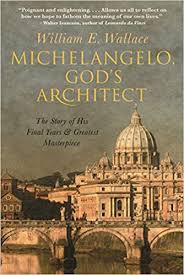Catherine Fletcher at Literary Review:
 Just as problematic for ‘God’s architect’ was the question of his private life. Although Wallace’s primary focus is on Michelangelo at work, he paints a picture too of the artist at home, whether at prayer, corresponding with family members or enduring the pain of kidney stones. His was not the archetypal household of its time and place: Michelangelo was unmarried and did not live with blood relatives. Nor does it fit the model of the characteristic male-dominated ecclesiastical house in Rome, for the simple reason that Michelangelo was not a cleric. There was, in fact, a great deal of the ‘found family’ about it: a motley bunch of ‘housemates’ (Wallace’s term) shared the same space, in some cases with their spouses, sometimes for business convenience, sometimes for more personal reasons.
Just as problematic for ‘God’s architect’ was the question of his private life. Although Wallace’s primary focus is on Michelangelo at work, he paints a picture too of the artist at home, whether at prayer, corresponding with family members or enduring the pain of kidney stones. His was not the archetypal household of its time and place: Michelangelo was unmarried and did not live with blood relatives. Nor does it fit the model of the characteristic male-dominated ecclesiastical house in Rome, for the simple reason that Michelangelo was not a cleric. There was, in fact, a great deal of the ‘found family’ about it: a motley bunch of ‘housemates’ (Wallace’s term) shared the same space, in some cases with their spouses, sometimes for business convenience, sometimes for more personal reasons.
Thanks to Gary Ferguson’s recent account of Renaissance Rome’s queer subculture, we now have more information with which to flesh out the might-have-beens of same-sex relationships at that time. But while elsewhere in the book Wallace is happy to fill in historical gaps with speculation, he opts for studied ambiguity when it comes to the precise nature of Michelangelo’s friendships with other men.
more here.
